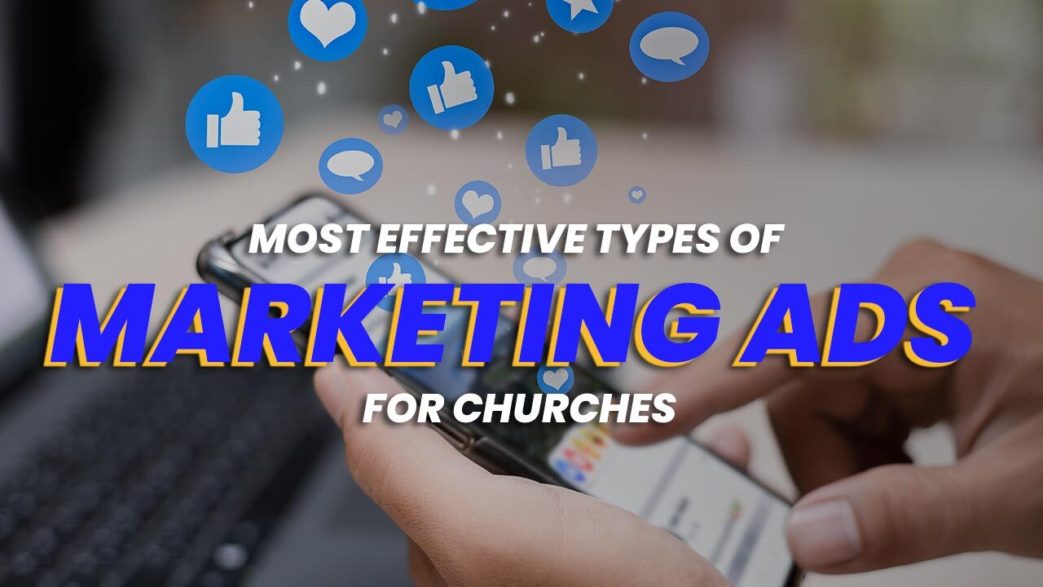Marketing ads for churches come in a vast variety of forms. Some are free, some cost money. No matter the type, one thing remains true. They are a necessity for helping to grow your church faster.
Whether you’re trying to boost your online community or reach a new audience for in-church membership, ads do help. The key is picking the right types. There’s Google, Facebook, email, radio, and so much more. But which is best for you?
In this article, we will break down using marketing ads for your church, and the top 12 types of marketing ads. As a bonus at the end, we’ll also cover tips for better ads, no matter what type you are using.
Ready to learn? Let’s jump in.
Estimated reading time: 16 minutes
Table of contents
Marketing Ads for Churches

In today’s world, churches need to reach out to their communities in new and innovative ways. That’s where church marketing ads come in! These ads can help spread the word about upcoming events, community outreach programs, and the welcoming atmosphere of the church.
Let’s explore some effective church advertising ideas, how to utilize a church website, and strategies for successful church marketing campaigns.
Effective Church Marketing Ideas
Church marketing ideas are all about getting creative and thinking outside the box. One effective idea is to create eye-catching flyers or posters that highlight upcoming events or sermon series. These can be distributed in the community or shared on social media platforms to reach a wider audience.
Another great idea is to host special events or workshops that appeal to different demographics within the community. For example, a cooking class for families or a financial planning workshop for young adults can attract new visitors to the church.
Additionally, forming partnerships with local businesses or organizations can help spread the word about the church’s mission and values. Collaborating on community service projects or hosting joint events can foster goodwill and strengthen connections within the community.
Utilizing a Church Website
A church website is an essential tool for reaching both current members and potential visitors. It serves as a hub for information about upcoming events, service times, and the church’s mission and values.
When creating a church website, it’s important to keep it user-friendly and visually appealing. Include clear navigation menus, prominent calls-to-action, and high-quality images that reflect the spirit of the church.
In addition to basic information, consider adding features such as online giving, prayer request forms, and audio or video recordings of sermons. These features can enhance the user experience and make it easier for people to engage with the church community.
Your website is important because it’s most likely to be the place your ads lead to. You want to make sure your ad money is worthwhile, and people actually want to stick around your website once they click on an ad.
Church Advertising Campaigns
A successful church marketing plan requires careful planning and execution. Start by defining clear goals and objectives for the campaign, whether it’s to increase attendance at Sunday services, attract new members, or raise awareness about a specific cause.
Next, identify the target audience for the campaign and choose the most appropriate channels for reaching them. This could include social media platforms, email newsletters, local newspapers, or even direct mail campaigns. This is where the 12 types of marketing ads come in (which we’ll cover in a second).
Once the campaign is underway, be sure to track its effectiveness and adjust strategies as needed. Analyzing metrics such as website traffic, social media engagement, and attendance at events can help determine what’s working and what needs improvement.
12 Types of Marketing Ads

So you’ll need some great church marketing strategies, a campaign to drive traffic, and a website that all that traffic leads to. Now what about the ads themselves? There are plenty of places you can put up advertisements.
From digital marketing to classic avenues like newspaper and radio, this section covers the top 12 types of ads for Christian church marketing. Typically, churches should consider several types of ads. This gives you the most overall reach. The good news is all these ads work well for churches of all sizes, including both new and old churches.
So let’s explore these 12 types of ads so we can find the right ones for you.
1. Google Ads
Since Google’s search engine handles over 3.5 billion searches daily, it’s not surprising that one of the top types of marketing ads for churches are Google ads. For perspective, as of August 2021, Google has already processed over 1.7 trillion searches for the year.
What sets Google ads apart from the rest is how many different places they might appear. Where exactly they appear varies greatly based on how you target your audience and customize your ad campaigns. But, they can appear in the following places online:
- Search results
- Google partner site search results (hundreds of options)
- Sites within the Google Display Network (Google-owned sites, Gmail, major news sites, etc.)
- Different types of devices based on location or other criteria (if you’re using a location-based ad, your ads might appear more on mobile devices, for example, if someone has their location setting turned on)
Naturally, your church’s ads won’t appear for every search and on every site. But, you do have the biggest reach overall. If you’re worried about the cost, don’t be. Churches and other non-profits are eligible to apply for Google Non-Profit Grants which include access to premium Google tools along with $10,000 in monthly ad credits. So, this really does make it a great solution for churches.
We’ve even created a list of tips for better managing your ads and how to get better overall results with your ads.
2. Facebook Ads
Outside of Google, Facebook likely has the biggest reach. With 1.88 billion daily active users and 2.85 billion monthly active users, people from every demographic are on Facebook. The great thing is you can take advantage of both the free and premium aspects of using Facebook for your church.
Build an active church community with an active Facebook page. Simply creating great, shareable posts goes a long way toward marketing your church. Of course, organic reach isn’t quite that easy on Facebook as the algorithms may only show a small portion of your posts to your followers each day or week. This is where ads come into play. Not only do you attract more people to your Facebook page/group, you reach current followers about upcoming events and other important announcements.
Like most online ads, you’re able to fully customize ad criteria to reach just the people you want. Trying to attract younger members? Edit your demographic settings based on age range. Want to only target your local community? Change your ad settings to certain cities, towns, states, etc.
If you’ve never considered Facebook advertising before, it’s well worth looking into. Our post on the 11 Elements Of Successful Facebook Ads can help your ads perform even better.
3. Twitter Ads
While not nearly as active as Facebook, Twitter ads are still some of the best marketing ads for churches. This is especially true if your church and audience aren’t exactly fans of Facebook and some of the controversies surrounding the platform. Twitter allows you to customize your approach and strategies are available for businesses and non-profits of all sizes.
Currently, Twitter has 199 million daily active users and 20% of US adults use Twitter. While it might not seem that impressive compared to Google and Facebook, that’s still a large number of users your church can reach. Ideally, you’d want to opt for Twitter ads when you have a major event going on, either online or offline. You’d probably be better off using Google or Facebook for more general growth purposes, such as increasing traffic to your church website.
Just like Facebook, consider building an active community on Twitter if possible. This gives you organic reach in addition to ad reach.
4. Instagram Ads

Instagram is actually owned by Facebook, so you get some of the same features. One thing that makes Instagram ads even easier to use is the Promote feature, which lets your church turn any post into an ad instantly. Did you just share a photo of a volunteer event? Promote it to help increase volunteers and online donations for the project.
You also get a pretty wide reach with Instagram’s 1.07 billion monthly active users and 500 million daily active users. Creating video ads really helps to grab attention since people love videos.
If your church is using Facebook and Instagram, you can even create cross-platform ads to further expand your ad’s reach. It’s a great way to simplify ad creation so you manage everything in one place, including checking your analytics to see how ads are performing.
5. Blog Posts
After all that talk about premium ads, “blog posts” might not seem like one of the more effective marketing ads for churches. However, think about the number of Google searches we mentioned at the beginning of this post. Every blog post your church writes is a new opportunity to appear in Google searches.
With properly optimized posts, your church shows up on the first page of results. For building online communities and reaching potential new visitors, this is one of the most cost-effective options. All you have to invest is time. Plus, having an engaging church blog helps you stay in contact with your members all week long. It also gives you great content to share on social media.
You might not get quite the instant results you may get with paid ads, but you will get results. It’s a good long-term strategy that benefits your church in many ways. And unlike other types of ads, your blog posts continue helping your church versus disappearing when your ad campaign is over.
If you need a little inspiration, check out the following:
- How Your Church Blog Can Turn Around Your Dwindling Numbers
- How To Write The Perfect Church Blog Post
- Creating A Church Blog Strategy
- Most Effective Blog Post Ideas For Churches
6. Email Newsletters
This type of ad isn’t quite like the rest. It’s the only type that involves people to opt-in before you can reach them. However, it’s easily one of the best marketing ads for churches if you’re trying to boost engagement with your current members and online followers.
For example, if you have members who only attend once a month or less, a highly engaging email newsletter keeps your church in the front of their minds. This increases the likelihood of them attending more often or at least checking out your church’s live stream. It can also help boost online tithing, volunteering, ministry group participation, online community building and more.
Plus, email newsletters are ideal for people who don’t use social media. Send regular newsletters with announcements on things currently going on, how to RSVP for upcoming events and links to your latest blog posts.
7. Website Landing Pages
Think of website landing pages as a blog post that’s made specifically for marketing purposes. Usually, this type of marketing ad works best when combined with another ad type. For instance, you might create Facebook ads that link back to your landing page.
Landing pages are highly focused on a specific goal. For example, if your church hosts a summer camp, you might create a landing page with all the details, benefits and how to sign up. You can keep landing pages online all the time (just change the details when appropriate) or use them on a temporary basis.
Make sure you include plenty of details and images for best results. Plus, if someone searches for your event name, your page should show up in organic search results.
8. Shareable Social Media Posts

If buying ads isn’t really in your budget right now, don’t worry. Free marketing ads for churches work well too. And, as we’ve already covered, Facebook, Twitter, and Instagram have huge active user numbers. Focus on building communities on one or more social media platforms. Posting regularly and creating posts people want to share is the best strategy.
Not only are you building a faith-based community for people to come together, you’re also able to market upcoming events, fundraisers and other things. Just remember, the majority of your posts should be useful and informative, not just marketing. Ideally, follow the Pareto Principle or 80/20 rule. This means only 20% of your posts should be directly marketing related. Use our social media strategy guide to learn how and what to post.
9. Local Newspapers
Yes, digital might be incredibly popular, but don’t underestimate the power of local newspapers. Print ads are still highly effective when you choose the right medium. If you’re trying to bring people together in your local community, advertise your church or church event in your local newspaper. Many people still subscribe. Plus, many local papers also have an online edition for those who prefer to read the news on their phone or tablet.
10. Ads In Local Businesses
Much like local newspapers, local businesses are a great place to market your church. Often, it helps if your church partners with the business. For instance, if a local bakery is donating bread for a spaghetti dinner, the bakery may be happy to place an ad on their wall or door to let people know about it. This helps you reach the bakery’s audience and shows off the bakery’s charitable side. It’s a win-win for everyone.
Some local businesses also charge a nominal fee to add your church’s name and/or ad to an advertising board, food mat, cup or other area of the business. Space is usually limited, but it’s a great way to let locals, tourists and those new to the area about your church.
11. Radio Ads
While many people might subscribe to satellite radio or ad-free music streaming services, you’d be surprised at how many people still prefer listening to local stations or ad-supported streaming services in order to save money. For example, iHeartRadio lets people tune in to live radio stations, along with custom stations, from around the world. The service has 128 million registered users and 250 million active monthly listeners. So, radio is still big.
For local marketing, consider purchasing ad time from a local radio station. You can usually choose what time of day you want the ads to run. For example, you might opt for 5:00 PM to 6:00 PM when more people are driving home from work and listening to the radio versus 10:00 AM to 11:00 AM when many people are stuck in meetings at work.
12. TV Ads
Many local stations, TV companies (that own multiple stations) and even streaming services (ad-supported) offer ad space to local businesses, including churches. Buying 15-30 seconds of ad time gives your church a chance to showcase what it’s like to attend. Or, if you have a community event coming up, invite people to attend. As a side note, many local TV stations and newspapers display upcoming events for free if you provide them with the details.
Tips For Better Overall Ads

Do you want a successful church marketing strategy? If so, your ads are not just going to have to be good. They have to be great. Now that you’ve explored the top 12 avenues of advertisements, let’s go over some bonus tips to improve your church marketing efforts.
Crafting Compelling Ads
Creating compelling ads is essential for catching people’s attention and driving engagement. Here are some tips to enhance the effectiveness of your ads:
Understand Your Audience
Before crafting your ads, take the time to understand your target audience. What are their interests, needs, and preferences? Tailor your messaging to resonate with them and address their pain points or desires.
Use Engaging Visuals
Visuals play a crucial role in grabbing attention and conveying your message quickly. Use high-quality images or videos that are relevant to your community events or church activities. Ensure that your visuals are eye-catching and align with your brand identity.
Compelling Copy
Write clear, concise, and compelling ad copy that communicates the value proposition of your church events or community activities. Use persuasive language to encourage action, such as attending a service or participating in an event.
Leveraging Digital Tools

In today’s digital age, leveraging digital tools can amplify the reach and impact of your ads. Here are some tips for utilizing digital tools effectively:
Utilize Google Ad Grants
Google Ad Grants offer nonprofits, including churches, free advertising credits to promote their mission and initiatives. Take advantage of this opportunity to increase visibility and drive traffic to your church online platforms.
Optimize for Search Engines
Implementing search engine optimization (SEO) techniques can improve your church website’s visibility in search engine results. Use relevant keywords related to your church events or community activities to ensure that your website ranks higher in search engine results pages.
Embrace Church Online
In addition to traditional advertising channels, embrace the power of church online platforms such as social media, email newsletters, and streaming services. Engage with your online community regularly by sharing updates, inspirational content, and event invitations to foster connections and drive engagement.
Bonus Tips
Here are some extra bonus tips to help you and your church out:
Target and Segment Your Audience
Whenever possible, use any tools available to segment your audience. The more targeted your approach, the better the results. You can also run different ads for different segments of your audience. This helps you reach more people with ads that they’ll respond to better.
Choose Ad Wording Carefully
Changing the phrasing of your ads can make a major difference in results, especially with online ads. Try A/B testing different types of wording to see what works best.
Run Multiple Campaigns at Once
Though we touched on this earlier, it’s worth mentioning again. Always run multiple campaigns at one time. This allows you to reach different groups of people. You can run multiple campaigns on a single platform (which is advisable for social media and Google ads) or just pick several types of ads to work with.
Church Marketing Ads

Effective church marketing ads are indispensable tools for fostering community engagement, spreading the message of faith, and inviting individuals to experience the warmth and inclusivity of the church. By implementing creative strategies, utilizing digital platforms, and understanding the needs of their audience, churches can effectively communicate their mission and values.
From promoting church events to reaching out to new members, these ads play a crucial role in connecting with people both within and beyond the congregation. As churches continue to adapt to the digital age, the power of marketing ads remains a vital component of a successful church marketing plan.
With dedication and innovation, churches can leverage these ads to make a positive impact and create meaningful connections that resonate with individuals seeking spiritual fulfillment and community involvement.
We pray that your marketing endeavors are fruitful. God bless!




